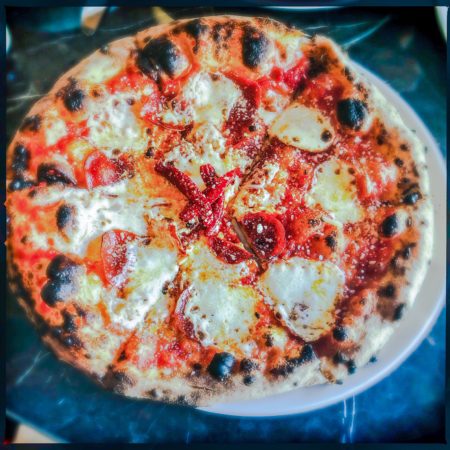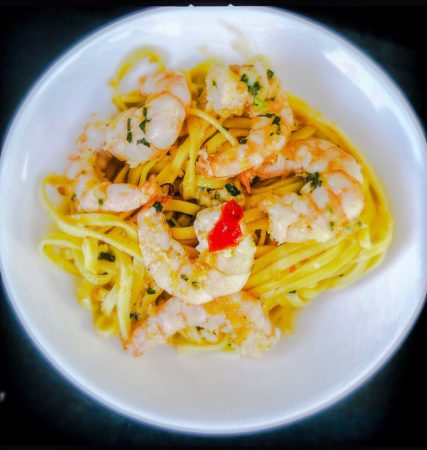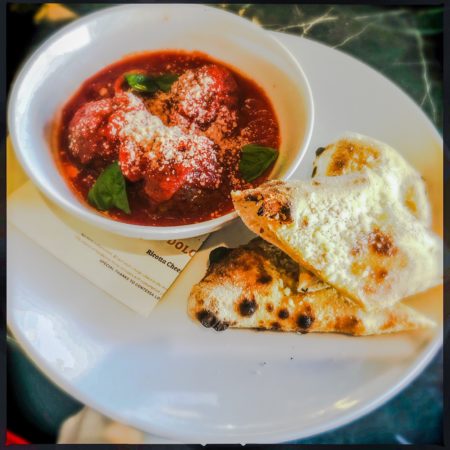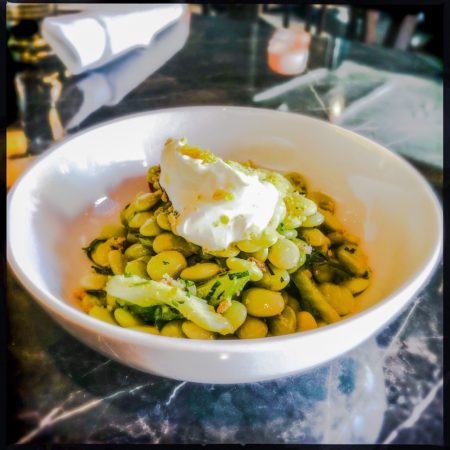Newer, bigger Monza shifts gears on a growing stretch of upper King Street (Charleston City Paper)
Originally opened in 2008, the once-tiny Monza pizzeria survived and thrived through the considerable, decade-long transformation of what is now Upper King Street. Seeing how said street has morphed over the years, a similar transformation of the original eatery was arguably in order.

Thus, in late October 2018, adjacent sister restaurant Closed for Business permanently called it a day. Restaurateurs Tim Mink and Brooks Reitz, the powerhouse duo behind Leon’s, Melfi’s, and Little Jack’s Tavern, spearheaded the overhaul. After tearing down the walls between the two establishments, they reconfigured the space, added a full bar, and modified the menu.
In summary, where the original Monza was narrow and cozy, the ’19 edition feels spacious and modern. Named for the historic Italian track, there’s still a subtle motor racing theme, mostly conveyed through old photos and the arty pizza boxes. In contrast to the expanded space, the updated menu presents a notably edited version of its predecessor.
The antipasti platter ($20) endures, and individual selections are now available a la carte for $6 a piece. The butterbean salad ($10) also remains. These days, the salad is served cold, the meaty beans tossed with crisp celery slices and a single cherry tomato, cut into quarters. Along with fresh fennel and mint, the toothy beans are imbued with the flavors of lemon and olive oil. Topped with creme fraiche and a sprinkle of crunchy breadcrumbs, it’s a bright, balanced selection, about as satisfying as a salad can be.

New to the menu, the ricotta meatballs ($13) are surprisingly tender, presumably thanks to the otherwise indiscernible cheese. Mildly flavored with visible fennel seeds, three substantial meatballs are bathed in a delicate red sauce, teeming with fresh tomato flavor. Accompanied by “naked pizza” — airy, wood-fired dough dusted with olive oil and parmesan — it’s a straightforward, shareable app that works.
In contrast, the shrimp scampi ($20) is disappointing. Getting recommendations from the despondent server was not easy, but she seemed to brighten up a touch while endorsing this dish. Alas, what arrives is a small bundle of linguine dressed with olive oil, lemon juice, and parmesan cheese, plus an unnamed mystery ingredient that’s unexpectedly really effing spicy. Each bite blazes a trail down one’s throat. Topped with six well-prepared shrimp, it’s alright, but not anything I’d order again.
In other news, the decision to combine the two restaurant spaces was a good one. Although open and lofty — a recipe for deafening noise levels — the vibe is pleasantly chill. Meanwhile, service was, for lack of a better word, depressed. Beyond taking our order, our particular server somewhat attended to our needs, for the most part talking with a fellow server and laying low.
A cheerful coworker delivered the Enzo pizza ($17), adorned with “pistachio pesto, smashed baby potatoes, and prosciutto, and finished with parmagiano fondue.” It sounded provocative, but, to quote my notes, “If fed this while blindfolded, I would not guess it was pizza.” The ingredients were clearly fresh and of the highest quality, but ultimately a celebration of blandness. The rare smashed potato — I consumed two slices without encountering one — is rich and buttery, but in short supply. If you’re familiar with the traditional Roman potato pizza, covered edge-to-edge with overlapping slices and dusted with rosemary, this is not that. Nonetheless, the thin, lightly charred crust shines.
On that note, let’s talk about the Count Louis pizza ($16). Historically, the Count Louis of yore was topped with roasted mushrooms, thick slices of pepperoni, and an ample layer of mozzarella and parmesan. These days, it’s a scantily clad pepperoni number, with two small rounds per slice.

Our new-look presentation was then adorned with a trio of Calabrian chili peppers, stacked in the center of the pie. Attempts to cut and spread the three tiny capsicums amongst the six slices left my dining companions to comment, “Spread the love. Why are they making us fight over three tiny peppers!?”
Alas, it’s still a great pizza. And such First World hang-ups point to what seems to be the fundamental driver behind the changes at Monza, the bottom line. Hey, I get it. King Street rents are expensive AF. Similarly, it seems the reinvented Monza Pizza Bar is managing that with a focus on a new target audience — hungry people who already happen to be on King Street, a.k.a. tourists.
As Charleston continues to skyrocket in price per square foot, win travel magazine accolades, and attract curious outsiders, these transformations will no doubt continue as a result of the fundamental effort to stay profitable. In the words of legendary stock car driver Dale Earnhardt, “The winner ain’t the one with the fastest car, it’s the one who refuses to lose.”







